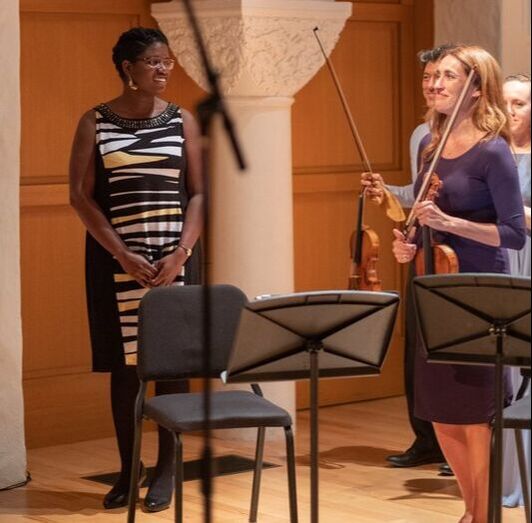|
Happy Sunday BIBA readers! Today's blog post is an artist feature of Sakari Dixon Vanderveer! A composer, violist, and educator, Ms. Vanderveer has received commissions and performances from a variety of soloists and ensembles, as well as performed with various chamber and orchestral groups. She is a promotor of contemporary music, and passionate about working with children to instill in them the importance of music and the power of new music. (photo credit: Shaun Frederickson)
BIBA : How did you enter the world of music and when did you realize you would like to pursue this path seriously? SD : I began studying the violin in fourth grade when orchestra was offered at my elementary school. At the time, I was much more interested in a career in the sciences. I was obsessed with animals, and by the sixth grade, I was determined to become a veterinarian. I literally sat in front of Animal Planet and took notes! However, I had several opportunities to compose for small ensembles in middle school, and a few years later, I knew that I wanted to become a professional composer. I will always cherish the teachers that helped me to become an instrumentalist, but I am even more grateful for the moments in which several of those same teachers encouraged me to compose. I feel as if music theory and composition are often neglected skills in band and orchestra classrooms due to pressure to perform and compete often. However, several of these teachers were willing to meet with me outside of class to give me valuable mentorship, even if they didn’t identify as composers themselves. BIBA : What inspires you most about composing? What frustrates you most? SD : One of the aspects of composing that I find most inspiring is the opportunity to write for specific performers or audiences. I try my best not to take for granted the ways in which music can connect seemingly dissimilar people in unexpected ways. In particular, I am driven by opportunities to reach out to children through contemporary music. Sometimes I feel as if kids are left out of experiencing new music because people assume that they won’t appreciate it, but from working with children for so long, I’ve learned that they have extremely open minds. As a Black female composer, I also believe that it is important for me to reach out to young musicians of underrepresented backgrounds because that encouraged me to pursue being a classical musician at a young age. For me, the most frustrating aspect of composing is both a blessing and a curse. Over the years, I’ve found that my creative endeavors are an effective means of getting to know myself better, even when I don’t really want to see what’s being revealed to me. I find that this is true not so much in the outcome of the work, but in the process of creating the work. For example, if I am struggling to find time to compose, or if I am having trouble staying focused while I’m writing, there are usually aspects of self care that I have not dealt with sufficiently. When I used to work in an office for eight hours a day, being short on sleep might have made it a little harder to stare at spreadsheets, but the impact did not compare to struggling to write music under the same conditions. BIBA : What have been some of your most rewarding past projects? SD : Two of my most rewarding projects in recent years took place earlier this spring. I had the privilege of being commissioned by MUSICA!, a chapter of El Sistema USA, to write a work for multi-level string orchestra entitled The Enigma of the Twilight Stallion. I had been teaching students in MUSICA! for the past couple of years at the time, and they were aware that I was both a violist and a composer, but I had not yet worked with them in that capacity. The best part of writing that piece was being able to imagine each individual student as I wrote while crafting parts that could both highlight their abilities and push their skills to a new level. As one of three Sounds Promising Young Composers for the Salastina Music Society’s last season, I wrote a piano quintet entitled “Obsidian, rippled in moonlight, gleams.” One of my favorite aspects of preparing that program was sitting in the rehearsals and concerts, listening to awe-inspiring music from all of the composers involved, and feeling so blessed to be amongst such talented people! I must admit, I was a little bummed when it was over -- the weekend went by so quickly that it felt surreal. BIBA : What are some of your upcoming projects? SD : This December, the Salastina Music Society in Pasadena, CA will premiere a piece that I have written for their program The Four Seasons x 2. On the program, they will perform the entirety of Vivaldi’s The Four Seasons alongside brand-new “seasons” from four SoCal composers including myself. The new works will use the same instrumentation as Vivaldi’s piece. For this project, I have chosen to pair each of the three movements of my piece with poems from California-based authors: Thea Gavin, Benjamin Gucciardi, and Donna Emerson. Additionally, I will be working on a duo for flute and guitar for Ciyadh Wells which will be premiered in the summer of 2020. Ciyadh Wells is a founding member of The Margins Guitar Collective, which devotes it energy to showcasing new works featuring the guitar by underrepresented composers. Their inaugural concert will be on December 1st of this year. BIBA : I give you the commission of a lifetime - ample funding, unrestricted resources, the freedom and time to create whatever you'd like. What piece would you compose? SD : I would absolutely love to write an album-length, multi-movement chamber symphony. Out of the ensembles that I have been following in recent years, I found that I am most drawn to medium-to-large chamber ensembles with atypical instrumentations that feature a solo player on each part. Perhaps it is because of my experience as an orchestral musician, where the default expectation is to blend in with one’s section, that I find the demand for bravura and raw individualism in a sinfonietta to be quite attractive. On the other hand, when instruments in such an ensemble do blend together, the supposed “imbalance” in voices creates new timbres that are both lucid and refreshing to my ears. ---- To learn more about Sakari Dixon Vanderveer and to listen to some of her music, please visit her website: http://www.sakaridixon.com, or follow her on instagram: @sakaridixon
0 Comments
Leave a Reply. |
Details
Writings, musings, photos, links, and videos about Black Artistry of ALL varieties!
Feel free to drop a comment or suggestion for posts! Archives
May 2024
|
Member Login
Black concert series and educational programs in Boston and beyond


 RSS Feed
RSS Feed










